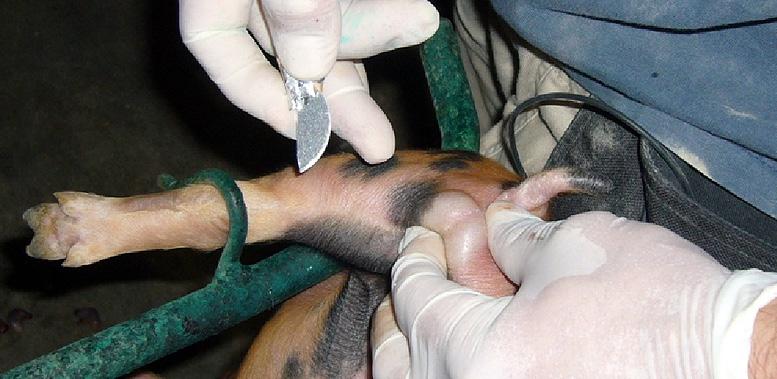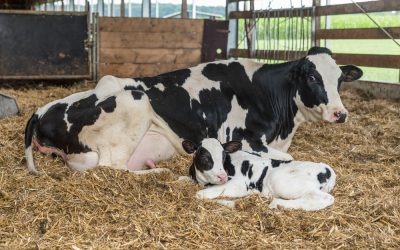D.Temple, E.Mainau, X.Manteca
More information
Download PDF Technical document
Castration in males consists of the removal of the testes or the inhibition of testicular function. Although the prevalence of castration in pigs varies from country to country, it is generally a routine practice that is performed surgically without anaesthesia in the first week of a piglet’s life. The main purpose of castration in pigs is to prevent boar taint, which is present in the meat of some entire males once they reach puberty. Other benefits of castration include: preventing unwanted reproduction in extensive systems, reducing aggressive and mounting behaviour with their resulting injuries, and the possibility of producing a higher-quality end-product.
BOAR TAINT: ANDROSTENONE AND SKATOLE
Boar taint is a defect affecting certain sensory properties of meat (odour and taste). It can be discerned when the meat is cooked or eaten and is considered unpleasant by many consumers. The main compounds responsible for boar taint are androstenone (a steroid pheromone synthesised in the testes) and skatole (a metabolite of the amino acid tryptophan). Lower amounts are found in females and castrated males than in entire males. While skatole can be partially controlled by diet, androstenone inhibition is only achieved by castration or inhibiting the luteinising hormone (LH) function.
CASTRATION IS A PAINFUL AND STRESSFUL PROCEDURE
Surgical castration of piglets is the usual practice. Typically, two incisions are made in the scrotum, the testes are freed from the surrounding tissue and taken out and discarded after severing the spermatic cord. While tearing is contraindicated, bleeding may be reduced by the use of an emasculator to crush the spermatic cords shut for a few seconds.
Surgical castration without anaesthesia or analgesia is considered to be a painful and stressful procedure, as evidenced by a series of physiological and behavioural changes that are clearly indicative of pain and stress. The procedure causes immediate pain which then becomes chronic, lasting for up to 5 days. Although scrotal incision involves acute, well-localised cutaneous pain, the most painful part of castration seems to be the extraction of the testes and severing of the spermatic cord, which produces a dull, diffuse, poorly localised, visceral pain.

Surgical castration with a scalpel
During castration, physical resistance by the piglet, increased heart rate, and high-frequency (>1 KHz) squealing are reliable indicators of pain. One study showed that castrated piglets aged 3, 10 and 17 days produced a larger number of squeals than restrained, non castrated animals (sham group). The number of squeals was also greater in piglets at 10 and 17 days of age than in piglets at 3 days of age. These data suggest that surgical castration without anaesthesia is painful at any age. Following castration, the concentrations of the hormones ACTH and cortisol, which are indicators of pain and stress, are 40 and 3 times higher respectively, than their baseline levels. Animals castrated without anaesthesia are less active than uncastrated ones. Specifically, there is a clear reduction in play behaviour and in piglets’ activity at the teat. Moreover, castrated piglets show specific signs of pain, such as turning their heads towards the affected area or scratching their hindquarters on the ground.
Surgical castration without anaesthesia can also negatively affect the animal’s growth, immune system and health. Post-surgical complications can include, among others, haemorrhage and excessive swelling, especially if the spermatic cords are severed but not crushed.
METHODS FOR MINIMISING AND CONTROLLING PAIN
A combination of anaesthesia and analgesia can be recommended to alleviate pain associated with surgical castration. General anaesthesia does not appear to be routinely applicable on farms, since the piglets take a long time to recover. As they remain lethargic and have a low body temperature throughout the recovery period, this can lead to a high piglet mortality rate. A good alternative appears to be local anaesthesia with lidocaine, injected either directly into the testicles or subcutaneously in the scrotum. A nonsteroidal anti-inflammatory drug (NSAID) should be administered to alleviate post-surgical pain. For instance, the administration of meloxicam prior to castration has been shown to reduce postoperative pain. Moreover, given that the animals may experience chronic pain for up to 5 days, the possibility of prolonging the analgesic treatment should be considered.
“SURGICAL CASTRATION OF PIGS SHOULD BE ABANDONED BY 1 JANUARY 2018”
BRUSSELS DECLARATION, 2010
ALTERNATIVES TO SURGICAL CASTRATION
- Rearing of entire males
Rearing entire (uncastrated) males is common in the United Kingdom and Ireland, where pigs are normally slaughtered before they reach puberty, with a carcass weight of about 75 kg. A future alternative may be genetic selection for animals with low boar taint.
- Immunocastration
With immunocastration (through injection of a vaccine prior to slaughter), the pig is immunised against gonadotropin-releasing hormone (GnRH). This immunisation inhibits the synthesis of LH, which, in turn, inhibits testosterone secretion and testicular function and development.
- Chemical castration
Chemical castration consists of injecting chemicals (such as lactic acid or zinc salts) into the testicles, causing local destruction of testicular tissue. In terms of welfare, it is difficult to draw definitive conclusions as further research is required to determine how painless the practice is.
- Breading females: sperm sexing
Sperm sexing consists of inseminating sows with sexed sperm so that they produce only female offspring. While sperm sexing may prove to be a good solution in the long term, it is not yet viable in practice.
LEGISLATION AND FUTURE OUTLOOK IN THE EU
Under current legislation on minimum standards for protection of pigs (Directive 2008/120/EC), male piglets can be surgically castrated without anaesthesia or analgesia up to 7 days old. After that, castration may only be performed under anaesthesia and with prolonged analgesia administered by a veterinary surgeon. However, due to the body of evidence indicating that surgical castration in the first 7 days of life is a painful practice, in 2010 a European Declaration on alternatives to surgical castration in pigs was signed. It is a voluntary declaration indicating that, from 1 January 2012, the surgical castration of pigs must be performed with anaesthesia and/or prolonged analgesia. Moreover, surgical castration should be abandoned by 1 January 2018. To achieve this, strategies must be developed to reduce the compounds responsible for boar taint, promote production and management systems that minimise sexual and aggressive behaviour in entire males, and develop an internationally recognised method for detecting boar taint at slaughter plants that is quick, easy, cheap and reliable.
It is worth noting that some countries have already adopted more restrictive measures. For instance, in 2009, Norway banned surgical castration, and in 2010, Switzerland banned surgical castration without anaesthesia in young pigs.
SUMMARY
Castration in pigs is primarily performed to prevent the boar taint present in the meat of some entire males once they reach puberty. A combination of anaesthesia and analgesia must be used with surgical castration to alleviate the pain and stress caused by this procedure. Consideration must likewise be given to alternatives, such as rearing entire males or immunocastration.
REFERENCES
- ALCASDE Project – Final Report: Study on the improved methods for animal-friendly production, in particular on alternatives to the castration of pigs and on alternatives to the dehorning of cattle, December 2009 (SANCO/2008/D5/018).
- European Declaration on alternatives to surgical castration of pigs, Brussels, 2010.
- PIGCAS Project – Final Draft: Attitudes, practices and state of the art regarding piglet castration in Europe, January 2009 (SANCO/Nº project 043969).
- Rault J-L, Lay Jr D C and Marchant-Forde J N 2011 Castration induced pain in pigs and other livestock Applied Animal Behaviour Science 135: 214-225.
- Marx G, Horn T, Thielebein J, Knubel B and von Borell E 2003 Analysis of pain-related vocalization in young pigs Journal of Sound and Vibration 266: 687-698.



